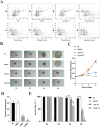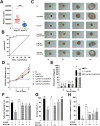Obesity Affects IVF Outcomes and Mevalonic Acid Rescues the Side Effects of Statins on Follicle Growth
- PMID: 40577089
- PMCID: PMC12204307
- DOI: 10.1096/fj.202500914R
Obesity Affects IVF Outcomes and Mevalonic Acid Rescues the Side Effects of Statins on Follicle Growth
Abstract
The accelerating trend of obesity in women of childbearing age has become a significant issue in personal health, female fecundity, and offspring development. Simvastatin (SV) is a statin commonly prescribed oral agent for lipid-lowering therapy; however, its applicability in reproductively active women remains controversial. In this study, through clinical data analysis, we further confirmed that obesity reduces in vitro fertilization pregnancy success, with significant decreases in the number of retrieved oocytes, mature oocytes, and cleavage embryos. We found SV inhibited follicle development cultured in vitro. Based on our previously reported metabolomics data, mevalonic acid (MVA) was found to be a key metabolite in follicular development. In our in vitro follicle culture system, we demonstrated that the supplement of MVA in SV-added follicles recovered to grow similar to the untreated blank group, indicating the rescue effect of potential reproductive toxicity of SV. Both the downstream metabolites cholesterol and geranylgeraniol partially attenuated SV-induced apoptosis elevation and proliferation suppression in KGN cells. RNA sequencing results suggested that this rescue effect may be mediated through the TNF, PI3K-Akt, and JAK-STAT pathways. Our study shed light upon clinical practice for women of childbearing age who were treated with statins and might contribute to better health management in obesity populations.
Keywords: follicular development; in vitro follicle culture; lipid metabolism; mevalonic acid; obesity; simvastatin.
© 2025 The Author(s). The FASEB Journal published by Wiley Periodicals LLC on behalf of Federation of American Societies for Experimental Biology.
Conflict of interest statement
The authors declare no conflicts of interest.
Figures




Similar articles
-
Individualised gonadotropin dose selection using markers of ovarian reserve for women undergoing in vitro fertilisation plus intracytoplasmic sperm injection (IVF/ICSI).Cochrane Database Syst Rev. 2018 Feb 1;2(2):CD012693. doi: 10.1002/14651858.CD012693.pub2. Cochrane Database Syst Rev. 2018. Update in: Cochrane Database Syst Rev. 2024 Jan 4;1:CD012693. doi: 10.1002/14651858.CD012693.pub3. PMID: 29388198 Free PMC article. Updated.
-
Oral medications including clomiphene citrate or aromatase inhibitors with gonadotropins for controlled ovarian stimulation in women undergoing in vitro fertilisation.Cochrane Database Syst Rev. 2017 Nov 2;11(11):CD008528. doi: 10.1002/14651858.CD008528.pub3. Cochrane Database Syst Rev. 2017. PMID: 29096046 Free PMC article.
-
Growth hormone for in vitro fertilisation (IVF).Cochrane Database Syst Rev. 2021 Nov 22;11(11):CD000099. doi: 10.1002/14651858.CD000099.pub4. Cochrane Database Syst Rev. 2021. PMID: 34808697 Free PMC article.
-
Recombinant luteinizing hormone (rLH) and recombinant follicle stimulating hormone (rFSH) for ovarian stimulation in IVF/ICSI cycles.Cochrane Database Syst Rev. 2017 May 24;5(5):CD005070. doi: 10.1002/14651858.CD005070.pub3. Cochrane Database Syst Rev. 2017. PMID: 28537052 Free PMC article.
-
Volume expanders for the prevention of ovarian hyperstimulation syndrome.Cochrane Database Syst Rev. 2016 Aug 31;2016(8):CD001302. doi: 10.1002/14651858.CD001302.pub3. Cochrane Database Syst Rev. 2016. PMID: 27577848 Free PMC article.
References
-
- Gonzalez M. B., Robker R. L., and Rose R. D., “Obesity and Oocyte Quality: Significant Implications for ART and Emerging Mechanistic Insights,” Biology of Reproduction 106 (2022): 338–350. - PubMed
-
- van der Steeg J. W., Steures P., Eijkemans M. J. C., et al., “Obesity Affects Spontaneous Pregnancy Chances in Subfertile, Ovulatory Women,” Human Reproduction 23 (2007): 324–328. - PubMed
MeSH terms
Substances
Grants and funding
- F202121/Maternal and Child Health Scientific Research of Jiangsu Province
- 81971451/MOST | National Natural Science Foundation of China (NSFC)
- 31900605/MOST | National Natural Science Foundation of China (NSFC)
- BK 20190654/JST | Natural Science Foundation of Jiangsu Province (Jiangsu Natural Science Foundation)
- JSSCTD202144/Innovative and Entrepreneurial Team of Jiangsu Province (JSSCTD202144)
LinkOut - more resources
Full Text Sources
Medical

